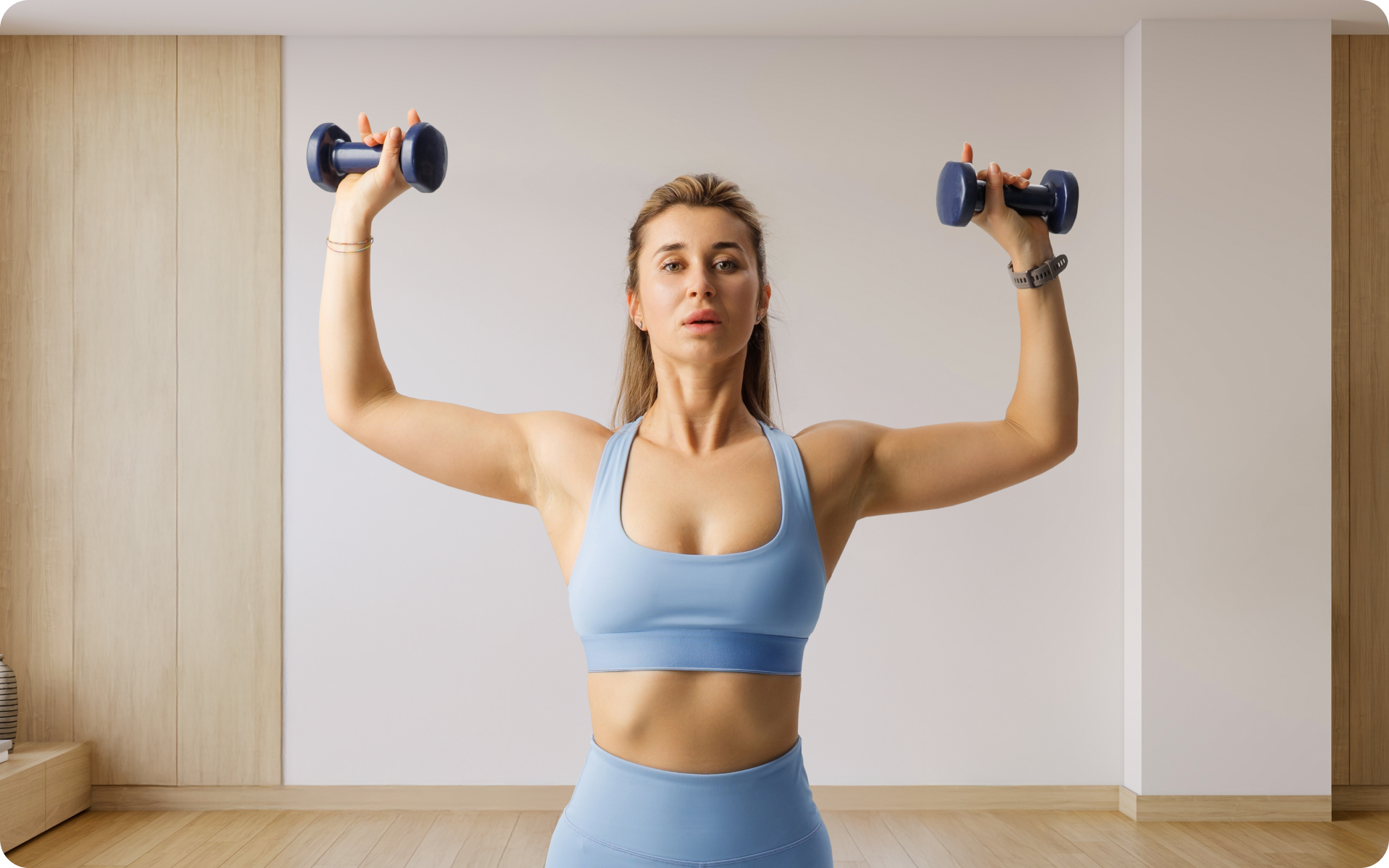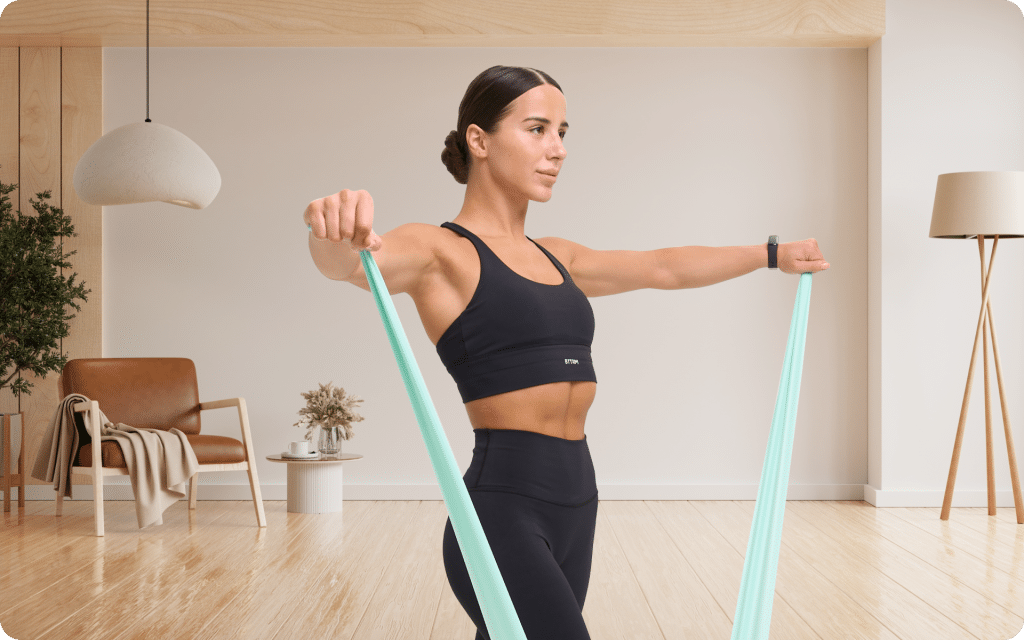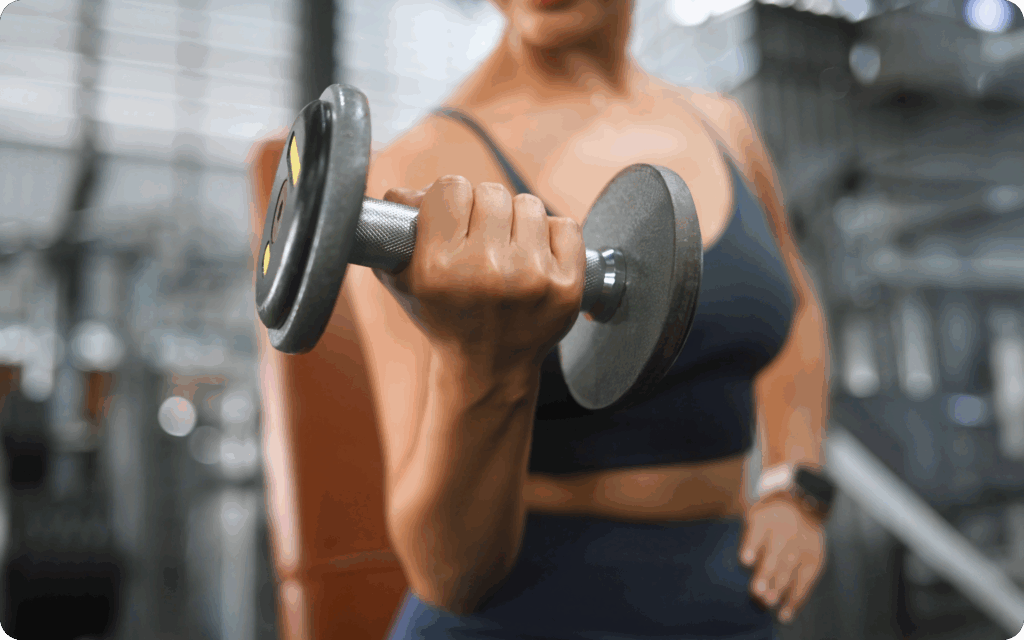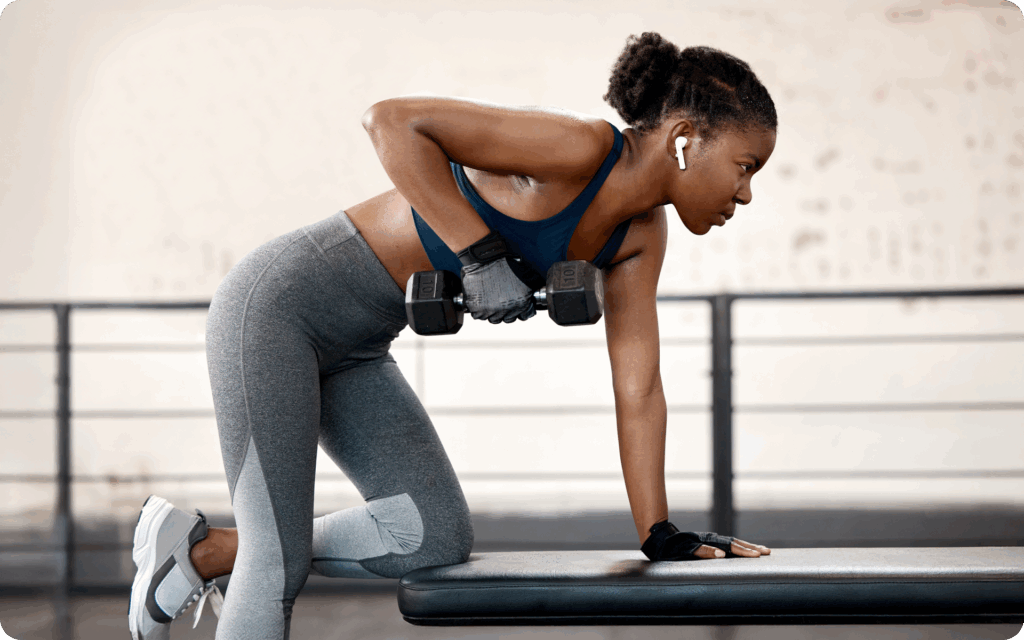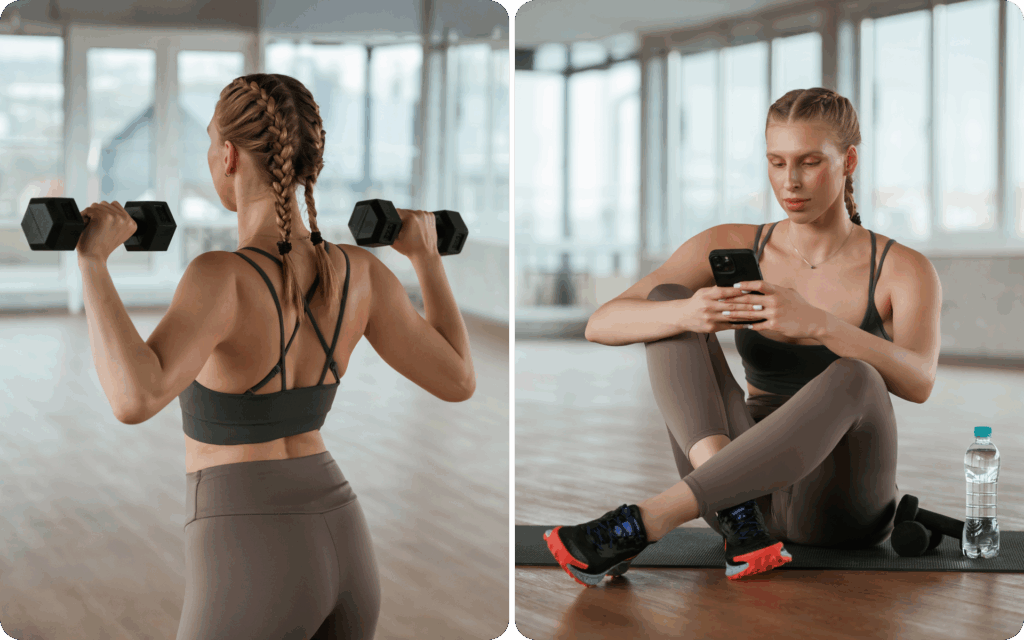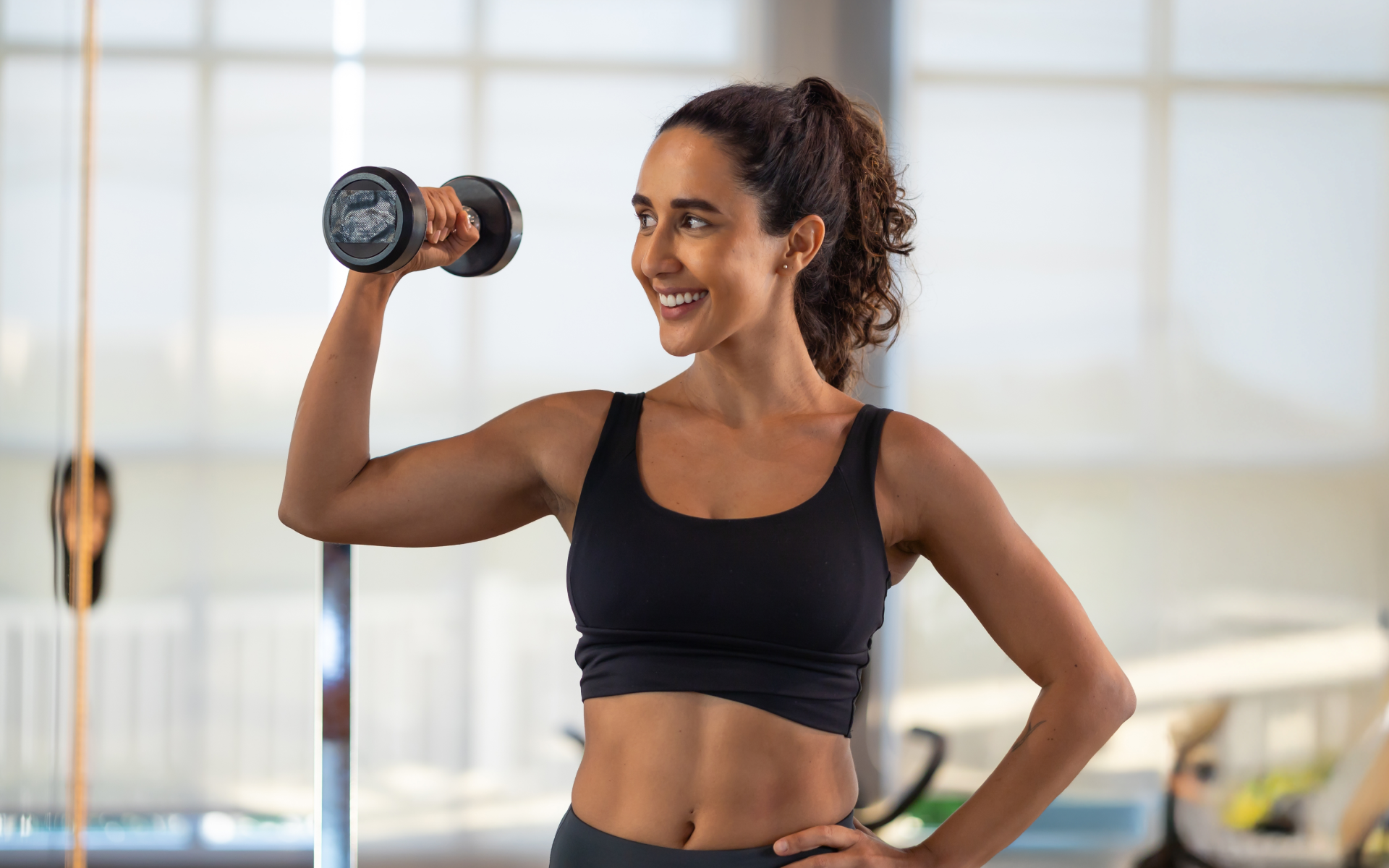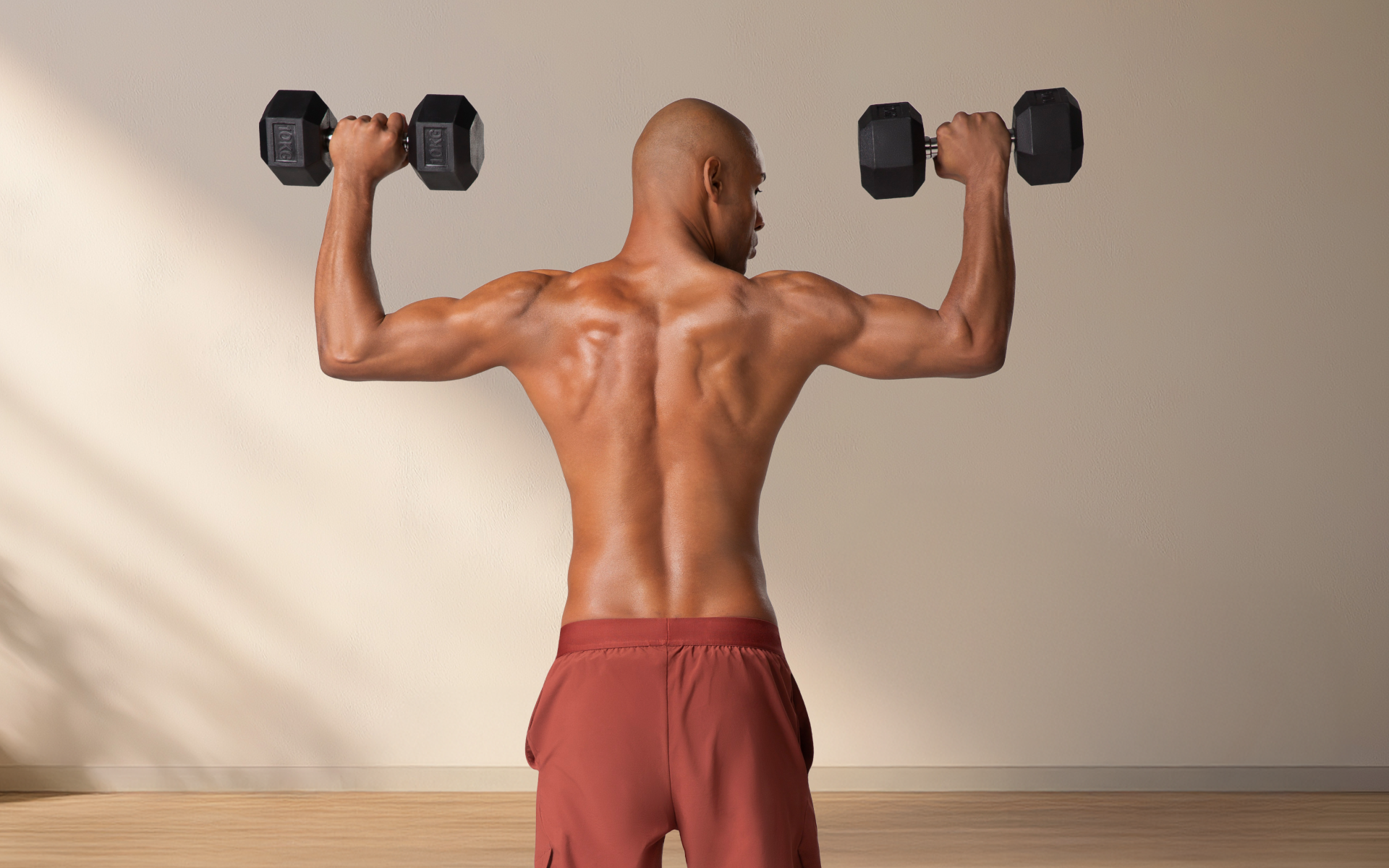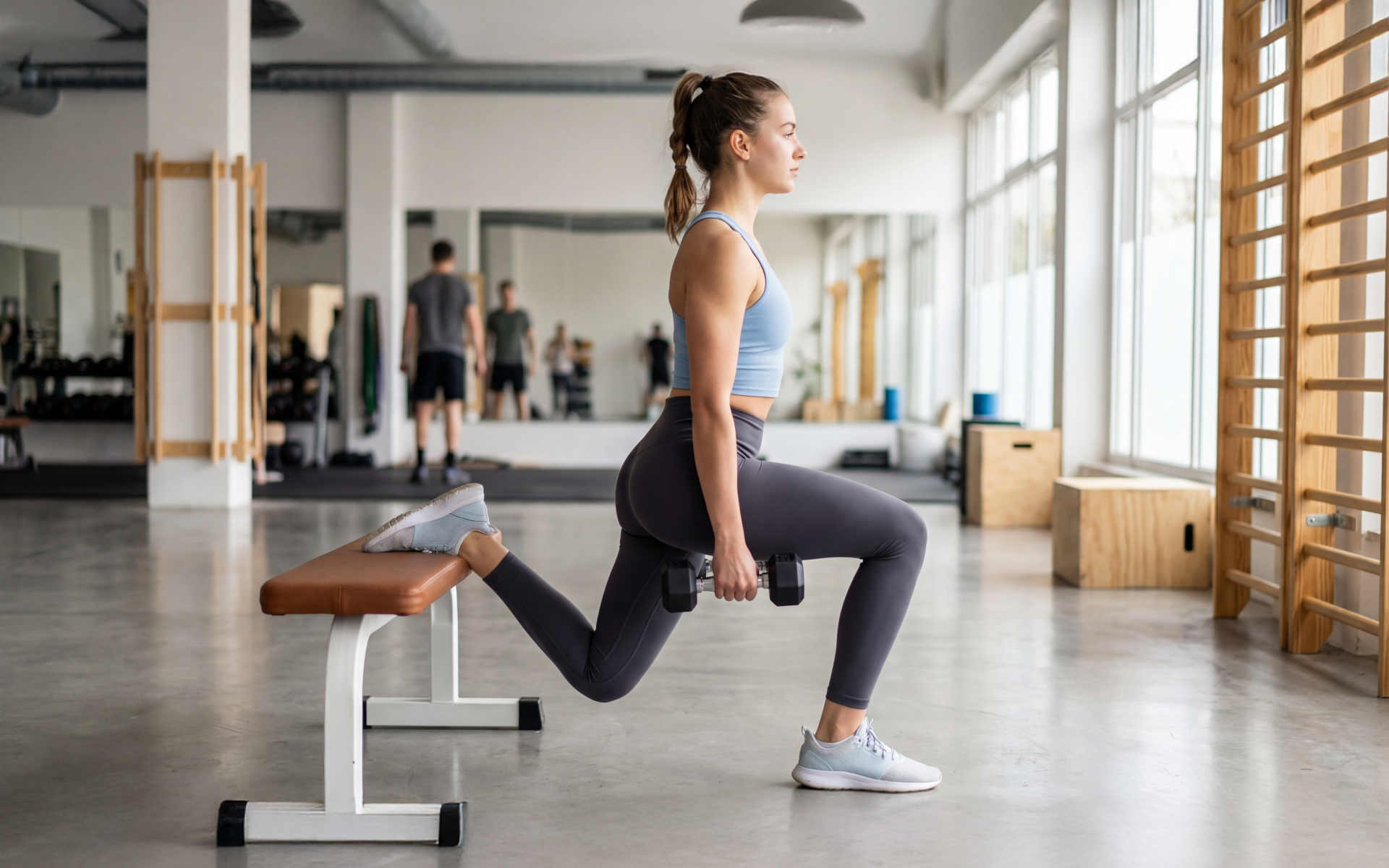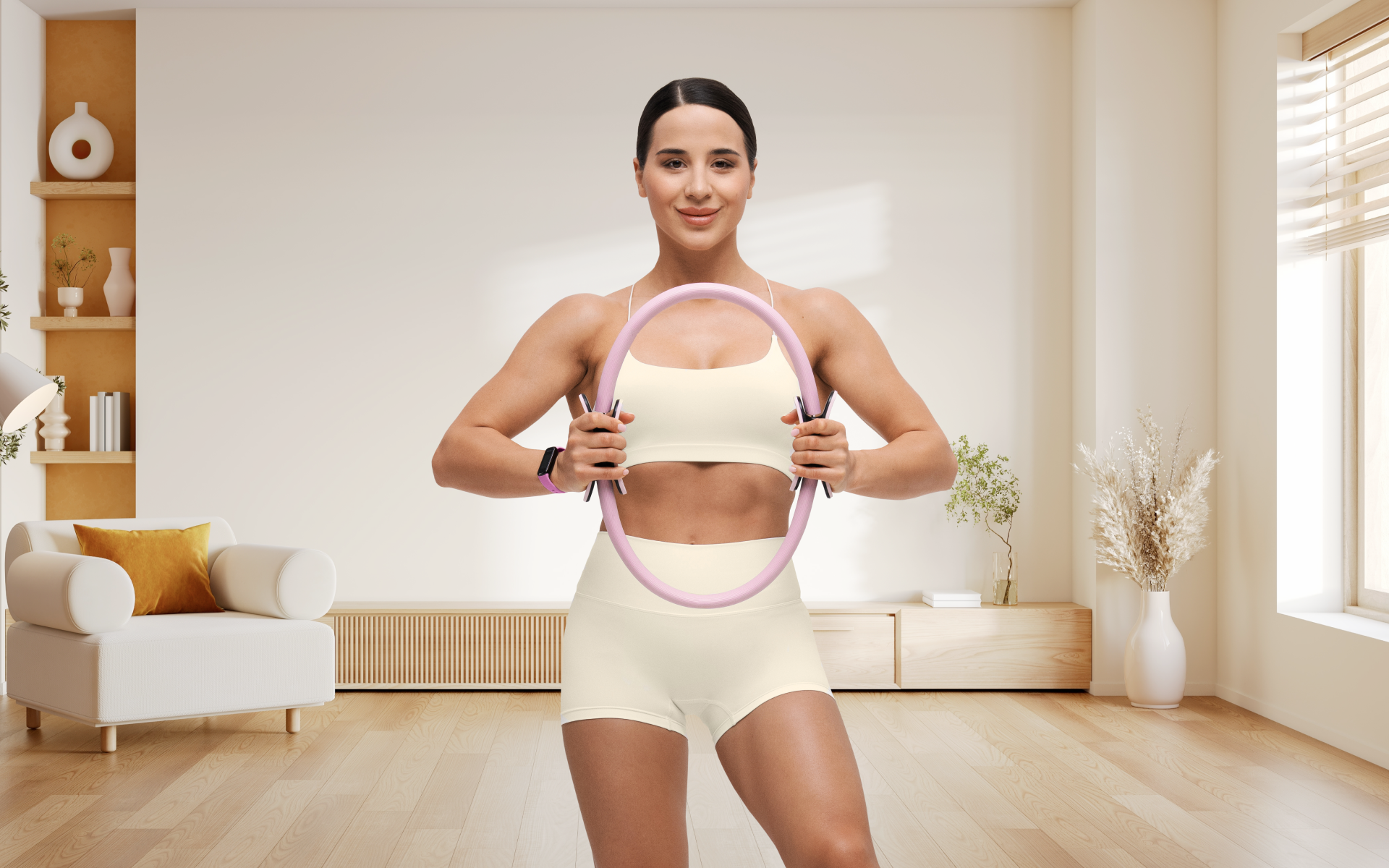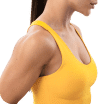Forearm training is often overlooked in favor of the more visible muscle groups such as chest and biceps. However, these smaller muscles play a crucial role in almost every upper-body exercise you perform. Strong forearms translate directly to better grip strength, enhanced performance in compound movements, and a reduced risk of injury during training.
The forearms consist of multiple muscles that work together to control wrist movement, finger flexion, and grip strength. When these muscles are well-developed, they provide the foundation for heavier deadlifts, more controlled pull-ups, and better overall arm aesthetics.
This comprehensive guide explores eight highly effective forearm dumbbell exercises that you can perform at home or at the gym. You’ll learn the proper techniques, understand the science behind each movement, and discover how to structure your training for maximum results.
Do I Need to Do Forearm Exercises?
Your forearms are complex structures that contain numerous muscles that serve five primary functions. Understanding these functions helps explain why dedicated forearm training is essential for complete arm development.
Forearm Anatomy and Functions
The forearm muscles control five key movements (1):
- Wrist and finger flexion: Curling your hand and fingers inward (bending your wrist)
- Wrist and finger extension: Moving your hand and fingers backward
- Radial deviation: Moving your thumb toward your forearm
- Ulnar deviation: Moving your pinky toward your forearm
- Pronation/Supination: Rotating your forearm and hand (palm up/palm down motion)
Each function requires specific muscles to work in coordination. The flexor muscles on the palm side of your forearm handle gripping and wrist flexion. The extensor muscles on the back of your forearm control wrist extension and finger opening.
Enhanced Grip Strength Performance
Strong forearms directly improve your grip strength, which impacts every pulling exercise in your routine. Grip strength directly impacts overall upper-body strength and functional capacity. The more you can grip, the more you can lift.
When your forearms are weak, they may become the limiting factor in exercises such as deadlifts, rows, and pull-ups (2, 3). You may have the back strength to perform more repetitions, but your grip will give out first.
Dedicated forearm training eliminates this weak link. Studies have demonstrated that individuals with stronger forearms can lift heavier weights for longer periods (2), which leads to greater muscle activation in target muscle groups.
Injury Prevention
Well-developed forearms provide stability to your wrist and elbow joints during training. This stability reduces stress on these joints and may decrease your risk of overuse injuries in the upper body (4).
The forearm muscles act as dynamic stabilizers during pressing movements such as bench press and overhead press. When these muscles are strong, they help maintain proper wrist alignment under load.
BetterMe: Health Coaching app helps you achieve your body goals with ease and efficiency by helping to choose proper meal plans and effective workouts. Start using our app and you will see good results in a short time.
Aesthetic Balance
From a visual standpoint, developed forearms create better proportion in your arms. Large biceps and triceps paired with small forearms create an imbalanced appearance.
Strong forearms also contribute to that “functional strength” look that suggests real-world capability rather than just gym-focused development.
For more comprehensive information about targeting all aspects of forearm development, check out our guide to forearm workouts.
Read more: Is a Calisthenics Everyday Split the Best Way to Build Muscle?
Can You Build Forearms with Dumbbells?
Dumbbells offer significant advantages for forearm training compared to other equipment options. Their versatility allows you to target all forearm functions while also providing the precise control that is needed for these smaller muscle groups.
- Advantages of Dumbbell Training
Unilateral Development: Dumbbells allow you to train each arm independently, addressing strength imbalances that commonly develop between your dominant and non-dominant hands (5).
Range of Motion: Unlike fixed machines, dumbbells permit natural movement patterns that closely mimic real-world activities (6).
Progressive Overload: You can easily increase resistance in small increments, which is essential for forearm development as these muscles respond well to gradual progression (7).
Convenience: Dumbbells enable effective forearm training at home, which eliminates the need for specialized equipment or gym access.
Grip Variation: You can easily adjust your grip width, hand position, and wrist angle to target different aspects of forearm strength.
- Equipment Accessibility
Most forearm dumbbell exercises require only a basic set of weights and a bench or sturdy surface. This makes forearm training accessible regardless of your training environment.
You can perform effective forearm workouts with relatively light weights. Many exercises use 5-15 pound dumbbells, which makes them suitable for beginners and advanced trainees alike.
How to Train Forearms with Dumbbells
Training forearms effectively requires understanding which movements target each of the five forearm functions. This ensures complete development rather than focusing on just grip strength.
Targeting Wrist Flexion
Wrist flexion exercises primarily target the flexor muscles on the palm side of your forearm. These muscles are responsible for closing your hand and curling your wrist toward your body.
Exercises such as wrist curls performed with your palms facing up specifically target these muscles. The key is controlling the weight through the full range of motion while maintaining constant tension.
Addressing Wrist Extension
The extensor muscles on the back of your forearm control wrist extension and finger opening. These muscles often lag behind the flexors in development, which creates imbalances.
Reverse wrist curls with palms facing down target these often-neglected muscles. Most people can handle less weight in extension movements compared to flexion exercises.
Training Radial and Ulnar Deviation
These sideways wrist movements are often completely ignored in traditional training programs. However, they may help prevent injuries in some people.
Specific exercises that move the wrist side-to-side target the muscles that are responsible for these functions. These movements also help prevent overuse injuries that are common in athletes who perform repetitive wrist motions.
Incorporating Pronation and Supination
The muscles that rotate your forearm are essential for many daily activities and sports movements. Training these functions helps develop the brachioradialis, a key muscle for forearm size.
Exercises that involve rotating the forearm while under load specifically target these functions. This rotation component is often what separates effective forearm training from basic wrist curls.
For additional upper-body training options that complement forearm development, explore our article, calisthenics workout for arms.
What Are Some Effective Forearm Dumbbell Exercises?
These eight exercises target all aspects of forearm function while providing progressive overload opportunities for continued development.
Dumbbell Wrist Curl (over Bench)
This exercise targets the wrist flexors on the palm side of your forearm, building both strength and size in these key grip muscles.
Biomechanics: The seated position with forearms supported on a bench isolates the wrist flexors while preventing compensation from other muscle groups. The supinated (palm-up) grip position maximally activates the flexor muscles.
How to perform:
- Grab a pair of dumbbells using an underhand grip and kneel in front of a flat bench.
- Rest the back of your forearms on top of the bench so your wrists hang just off the end.
- Allow the dumbbells to roll down to your fingertips, creating maximum stretch in the flexors.
- Slowly curl the dumbbells up using only your wrists, squeezing at the top.
- Lower with control back to the starting position.
- Perform 12-15 repetitions with moderate weight.
Reverse Grip Dumbbell Wrist Curl (over Bench)
This exercise targets the often-neglected extensor muscles on the back of your forearm, which are essential for balanced development and injury prevention.
Biomechanics: The pronated (palm-down) grip position shifts emphasis to the extensor muscles. These muscles are typically weaker than the flexors, so expect to use lighter weights.
How to perform:
- Grab a pair of dumbbells using an overhand grip and kneel in front of a flat bench.
- Rest your forearms on the bench with wrists hanging off the end and your palms facing down.
- Allow the dumbbells to lower as far as possible, stretching the extensors.
- Curl the dumbbells up using only your wrists, focusing on the muscles on the back of your forearms.
- Pause at the top and squeeze before lowering slowly.
- Perform 15-20 repetitions with lighter weight than flexion exercises.
One Arm Reverse Dumbbell Wrist Curl (over Bench)
This unilateral variation allows you to focus on each arm independently while addressing any strength imbalances between sides.
Biomechanics: Working one arm at a time allows for greater concentration and control. You can use your free hand for support and stability.
How to perform:
- Grab a dumbbell with an overhand grip and kneel beside a bench.
- Rest one forearm on the bench with your wrist hanging off the end.
- Place your free hand on the bench for stability.
- Allow the dumbbell to lower as far as possible.
- Curl the weight up using only your wrist, focusing on controlled movement.
- Complete all repetitions on one side before switching arms.
- Perform 12-15 repetitions per arm.
Seated Neutral Grip Dumbbell Wrist Curl
The neutral grip position targets the forearm muscles from a different angle while also engaging stabilizing muscles around the wrist.
Biomechanics: The neutral (thumbs-up) grip position engages both flexor and extensor muscles while requiring additional stabilization from smaller forearm muscles.
How to perform:
- Sit on a bench holding dumbbells with a neutral grip (thumbs pointing up).
- Rest your forearms on your thighs with your wrists hanging past your knees.
- Allow the dumbbells to lower as far as possible while maintaining the grip.
- Curl the weights up using your wrists, squeezing at the top.
- Lower back to the starting position with control.
- Perform 12-15 repetitions, focusing on the squeeze at the top.
Dumbbell Overhead Carry
This functional exercise challenges grip strength while engaging your entire core and shoulder complex for stability.
Biomechanics: Holding weight overhead requires constant grip engagement while challenging your shoulder stability. The extended arm position increases the difficulty compared to other carry variations.
How to perform:
- Grab dumbbells and press them overhead with your arms fully extended.
- Engage your core and maintain a straight posture.
- Walk forward for a predetermined distance or time (20-30 seconds).
- Focus on maintaining a steady grip without allowing the weights to drift.
- Keep your shoulders active and engaged throughout the movement.
- Lower the weights safely when completed.
Reasons why BetterMe is a safe bet: a wide range of calorie-blasting workouts, finger-licking recipes, 24/7 support, challenges that’ll keep you on your best game, and that just scratches the surface! Start using our app and watch the magic happen.
Fat Gripz Dumbbell Farmers Carry
Fat Gripz are thick rubber sleeves that slip over dumbbell handles, which increases grip difficulty and forearm activation.
What are Fat Gripz: Fat Gripz are specialized training tools that increase the diameter of any bar or handle. This forces your grip muscles to work much harder to maintain control of the weight.
Are Fat Gripz necessary? While not absolutely essential, Fat Gripz increase the training stimulus for your forearms. If you don’t have Fat Gripz, you can wrap towels around dumbbell handles for a similar effect.
How to perform:
- Attach Fat Gripz to dumbbell handles or wrap towels around them.
- Pick up the dumbbells with the thickened grips.
- Stand tall and walk forward, maintaining perfect posture.
- Focus on maintaining a secure grip throughout the carry.
- Walk for 30-60 seconds or until grip failure.
- Rest and repeat for 3-4 sets.
One-Arm Dumbbell Reverse Grip Curl
This exercise combines forearm training with bicep work while emphasizing the brachioradialis muscle that contributes significantly to forearm size.
Biomechanics: The reverse grip shifts emphasis from the biceps to the brachioradialis and forearm extensors. Working one arm at a time allows for maximum focus and control.
How to perform:
- Stand holding a dumbbell with an overhand grip with your arm at your side.
- Keep your elbow close to your body throughout the movement.
- Curl the weight up, focusing on the muscles in your forearm rather than your bicep.
- Squeeze at the top, emphasizing the brachioradialis contraction.
- Lower slowly with control.
- Complete all reps on one side before switching arms.
- Perform 8-12 repetitions per arm.
Reverse Grip Dumbbell Preacher Curl
Using a preacher bench eliminates momentum while the reverse grip maximally targets the brachioradialis and forearm extensors.
Biomechanics: The preacher bench position prevents cheating while the reverse grip shifts emphasis away from the biceps toward the forearm muscles. This combination provides intense stimulation for often-neglected muscles.
How to perform:
- Sit at a preacher bench holding dumbbells with an overhand grip.
- Rest your upper arms against the pad with your arms slightly bent.
- Keep your wrists straight throughout the movement.
- Curl the weights up, focusing on your forearm muscles.
- Squeeze at the top of the movement.
- Lower slowly, maintaining control throughout.
- Perform 8-12 repetitions with moderate weight.
For additional bodyweight options to complement your dumbbell training, check out our Forearm Bodyweight Exercises.
Read more: How To Workout Shoulders: A Beginner’s Guide (2025)
Should I Train Forearms with High Reps?
You can train your forearms with high reps, but the optimal rep range will depend on your specific goals and training experience.
- Research on Forearm Training Volume
Forearm muscles adapt well to frequent, moderate-volume training. Studies have shown that training forearms 2-3 times per week with moderate intensity produces better results than infrequent, high-intensity sessions (8).
- Recommended Rep Ranges
For Strength: 6-8 repetitions with heavier weights develop maximal grip strength and power.
For Size: 12-15 repetitions with moderate weights provide the optimal stimulus for muscle growth.
For Endurance: 20-25 repetitions with lighter weights improve muscular endurance and grip stamina.
Most trainees will benefit from incorporating all three rep ranges into their program over time. This varied approach ensures complete development of all muscle fiber types.
- Training Frequency
Forearms can typically handle training 3-4 times per week. However, if you perform significant pulling work in your regular routine, 2 dedicated forearm sessions per week may be sufficient.
Monitor your recovery carefully. If your grip strength decreases or you experience persistent soreness, reduce the training frequency or volume.
Yes, bicep curls do work the forearms to a certain extent, but not optimally for forearm development. During bicep curls, your forearm muscles act as stabilizers to maintain wrist position and grip the weight. However, this is secondary activation rather than primary training. The forearm involvement in bicep curls is mainly isometric (static contraction) rather than dynamic movement. This provides some benefit, but it doesn’t target the full range of forearm functions or provide adequate stimulus for significant growth. Hammer curls work the forearms more effectively than regular bicep curls due to the neutral grip position. The neutral grip (thumbs up) position activates the brachioradialis muscle more significantly, which contributes to forearm size and strength. However, hammer curls still primarily target the biceps and should be considered supplementary to dedicated forearm exercises rather than replacements for them. Standard push-ups provide minimal forearm activation, mainly through isometric grip strength to maintain hand position. The primary muscles worked are the chest, shoulders, and triceps. However, certain push-up variations can increase forearm involvement. Push-ups performed on the fingertips, with hands in different positions, or using unstable surfaces such as medicine balls require greater forearm stabilization. Forearms can potentially be trained daily, but this isn’t necessary or recommended for most people. Daily training increases the risk of overuse injuries and may not provide additional benefits over training 3-4 times per week. If you choose to train your forearms daily, use lighter weights and vary the exercises to avoid repetitive stress. Monitor your recovery carefully and reduce frequency if you experience persistent soreness or decreased performance.Frequently Asked Questions
Do bicep curls work the forearms?
Do hammer curls work the forearms?
Do push-ups work the forearms?
Can I hit my forearms daily?
The Bottom Line
The key to effective forearm development lies in consistent, progressive training that targets all forearm functions. These eight dumbbell exercises provide a complete foundation for building stronger, more muscular forearms that will enhance your overall training performance and arm aesthetics.
By incorporating these exercises into your routine 2-3 times per week and focusing on proper form and progressive overload, you’ll develop grip strength, improve your athletic performance, and prevent injury.
DISCLAIMER:
This article is intended for general informational purposes only and does not serve to address individual circumstances. It is not a substitute for professional advice or help and should not be relied on for making any kind of decision-making. Any action taken as a direct or indirect result of the information in this article is entirely at your own risk and is your sole responsibility.
BetterMe, its content staff, and its medical advisors accept no responsibility for inaccuracies, errors, misstatements, inconsistencies, or omissions and specifically disclaim any liability, loss or risk, personal, professional or otherwise, which may be incurred as a consequence, directly or indirectly, of the use and/or application of any content.
You should always seek the advice of your physician or other qualified health provider with any questions you may have regarding a medical condition or your specific situation. Never disregard professional medical advice or delay seeking it because of BetterMe content. If you suspect or think you may have a medical emergency, call your doctor.
SOURCES:
- Anatomy, Shoulder and Upper Limb, Forearm Muscles (2023, ncbi.nlm.nih.gov)
- Handgrip Strength as an Indicator of Overall Strength and Functional Performance—Systematic Review (2025, mdpi.com)
- Forearm Torque and Lifting Strength: Normative Data (2018, pubmed.ncbi.nlm.nih.gov)
- UNLOCKING THE SECRETS OF STRONGER ARMS AND ELBOWS: A COMPREHENSIVE GUIDE (2025, physicianpartnersofamerica.com)
- Comparison of Muscle Growth and Dynamic Strength Adaptations Induced by Unilateral and Bilateral Resistance Training: A Systematic Review and Meta-analysis (2025, pubmed.ncbi.nlm.nih.gov)
- Understanding the Distinction Between Machine-Based vs Free Weight Training and Their Correlation to Mobility (2023, kosalbjournal.com)
- Effects of Training With Free Weights Versus Machines on Muscle Mass, Strength, Free Testosterone, and Free Cortisol Levels (2020, journals.lww.com)
- Effects of Resistance Training Frequency on Measures of Muscle Hypertrophy: A Systematic Review and Meta-Analysis (2016, link.springer.com)
